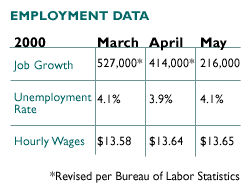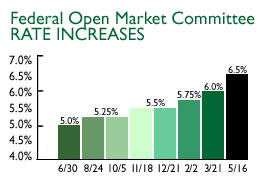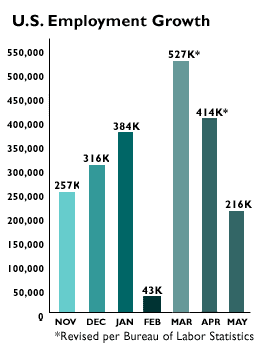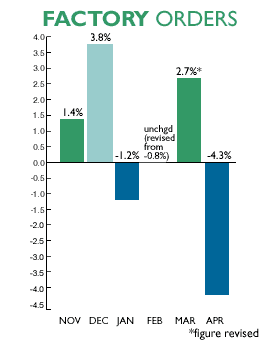|
Job growth takes a break
|
 |
June 2, 2000: 1:47 p.m. ET
231,000 jobs created in May; wages up 1 cent; jobless rate rises to 4.1%
By Staff Writer M. Corey Goldman
|
NEW YORK (CNNfn) - Hiring by U.S. companies declined for the first time in more than four years in May while workers' wages barely budged and the unemployment rate edged higher -- the strongest signs yet that the world's largest economy may be slowing due to higher interest rates.
|

|
VIDEO
|
|
 CNN's Dan Ronan reports on summer worker shortage across the country.
CNN's Dan Ronan reports on summer worker shortage across the country.
|
|
Real
|
28K
|
80K
|
|
Windows Media
|
28K
|
80K
|
|
The economy created 231,000 jobs last month, the Labor Department reported Friday, well below Wall Street forecasts and the revised 414,000 jobs added in April. All of the job gains came from government hiring, the report said. Excluding the 347,000 workers the government hired last month - related to the census -- U.S. companies actually shed 116,000 jobs, the Labor Department said.
Stocks and bonds surged in the wake of the report as investors concluded that companies are starting to scale back hiring, a sign that overall demand for goods and services is slowing, lessening the need for workers. That, in turn, means less of a threat of accelerating inflation, something Federal Reserve officials have been trying to avert by raising interest rates.
"This is a perfect jobs report," said Bill Cheney, chief economist with John Hancock Financial Services in Boston. "Job growth slowed significantly and there are absolutely no signs of inflation. Greenspan may be pulling off what once seemed impossible: two soft landings in one economic expansion."
Finally, some slowing
Separately, factory orders posted their steepest monthly decline in almost a decade in April, the Commerce Department said.
The primary driver behind the U.S. economy's unparalleled nine-year expansion has been the robust labor market, with a shortage of skilled workers needed to produce the goods and services consumers demand spurring companies to hire as never before.
 Analysts, investors and Fed officials have been concerned that that pace of hiring, combined with a growing shortage of workers, would spur companies to pay higher wages to keep their employees happy and on the job. And to keep profits up, those companies would be forced to pass on their rising costs to consumers in the form of higher prices. Analysts, investors and Fed officials have been concerned that that pace of hiring, combined with a growing shortage of workers, would spur companies to pay higher wages to keep their employees happy and on the job. And to keep profits up, those companies would be forced to pass on their rising costs to consumers in the form of higher prices.
That is why the influential Federal Open Market Committee has raised short-term rates six times in the past year, the most recent move a half-point increase May 16. The fed funds rate, the benchmark rate commercial banks charge each other for overnight loans, is now 6.50 percent; the prime rate, which banks charge their best clients for loans, is now 9 percent.
Recently, the economy has begun to show signs that it is starting to respond to those rate increases. Reports of slowing manufacturing output, lower construction spending, falling home sales and declining orders for durable goods all indicate that consumers and businesses are starting to feel the effects of rates that are 1-3/4 percentage points higher than a year ago.
Inflation a no-show
And inflation, with the exception of a one-month surge in March when consumer prices advanced 0.7 percent, inflation has remained incredibly tame, analysts said. Average hourly wages, a closely watched harbinger of inflation, rose 1 cent to $13.65 an hour, a smaller-than-expected increase of 0.1 percent. The jobless rate rose to 4.1 percent from 3.9 percent.
 Friday's report was the strongest piece of evidence to date that the economy is beginning to slow down, Anthony Chan, chief economist with Banc One Investment Advisors, told CNNfn. Friday's report was the strongest piece of evidence to date that the economy is beginning to slow down, Anthony Chan, chief economist with Banc One Investment Advisors, told CNNfn.
"I think this employment report shows that the laws of gravity do apply to monetary policy," Chan said. "If you raise rates high enough, the economy will slow," he said, adding that Friday's employment numbers may prompt Fed officials to think twice about raising rates at their June 27-28 policy meeting. (285KB WAV) (285KB AIFF)
Bruce Steinberg, chief economist with Merrill Lynch, revised his prediction for a June rate increase by the Fed, suggesting that Friday's report could be the catalyst that ends the central bank's series of rate hikes.
The 'dot.bomb' phenomenon?
"We are changing our opinion on the Fed call at the next FOMC meeting," Steinberg said. "We think the Fed will not raise the fed funds rate at the June 28 meeting. That does not preclude a further move at the next FOMC meeting in August, [but] there is a chance that they are finished with this tightening cycle."
 Financial markets agreed with Steinberg's assessment. The implied yield on the July fed funds futures contract, which indicates where investors think the fed funds rate will be down the road, fell 10 basis points Friday to 6.61 percent. Since the Fed's May 16 rate increase, that yield has dropped 16 basis points. Financial markets agreed with Steinberg's assessment. The implied yield on the July fed funds futures contract, which indicates where investors think the fed funds rate will be down the road, fell 10 basis points Friday to 6.61 percent. Since the Fed's May 16 rate increase, that yield has dropped 16 basis points.
In its report, the department said services employment rose by 278,000 while retail employment fell 67,000; the biggest drop since January 1991. That followed a 176,000 increase in April. Construction employment fell by 29,000 after while manufacturing-related positions declined by 17,000.
No doubt, what's good news on Wall Street isn't always good news on Main Street. The recent "dot.bomb" phenomenon, where negative investor sentiment has significantly reduced the value of publicly traded Internet and technology companies, already has spurred many firms either to scale back their hiring intentions or let go of workers altogether.
Productivity still a factor
And market volatility in general has made people think twice about pulling out all the stops on big-ticket purchases such cars, appliances and home furnishings, something that could lead to even lower demand for workers in the months ahead, particularly in the resilient manufacturing sector.
 U.S. Labor Secretary Alexis Herman said it was clear that the economy took a breather last month, but that the fundamentals -- strong growth, low inflation and strides in productivity -- still remain, a combination that should continue to fuel job gains in the months ahead. U.S. Labor Secretary Alexis Herman said it was clear that the economy took a breather last month, but that the fundamentals -- strong growth, low inflation and strides in productivity -- still remain, a combination that should continue to fuel job gains in the months ahead.
What's more, the Labor Department is working with business to fill the gap between workers looking for a job and companies looking for skilled labor, she noted. "This is an economy that needs skilled workers, and what we're trying to do is manage the change that is taking place, particularly where we would see any dislocation in the high-tech industry."
And there is still productivity to consider, Herman said -- where everything from smaller and faster computer chips to wireless telephones to new and innovative ways to move information quickly from one end of the world to the other has enabled companies to produce more without boosting their overall costs and raising prices. Productivity, a measure of worker output per hour, rose at an annual rate of 2.4 percent in the first three months of 2000, according to the Labor Department.
Factory orders falter
The labor pool, which measures the number of workers ready and able to fill existing positions, grew to 10.2 million in May from 9.9 million in April, based on new seasonally adjusted figures from the Labor Department. The portion of the U.S. population holding jobs slipped to 64.3 percent from a record 64.9 percent in April.
 In a separate report, the Commerce Department said Friday that orders for U.S. manufactured goods posted their sharpest decline in nearly a decade in April as demand for electronics and electrical goods faltered dramatically. In a separate report, the Commerce Department said Friday that orders for U.S. manufactured goods posted their sharpest decline in nearly a decade in April as demand for electronics and electrical goods faltered dramatically.
Factory orders fell 4.3 percent in April following a revised gain of 2.7 percent the month before. April's decline was much steeper than the 3 percent fall predicted by economists, and was the largest decline since a 5.1 percent drop in November of 1990.
April's contraction was spurred by a 6.5 percent decline in orders for long-lasting durable goods such as cars, appliances and furniture. Within the durable goods category, orders for electronics and electrical goods slumped a whopping 20.2 percent, the steepest monthly drop on record. 
|
|
|
|
|
 |

|

